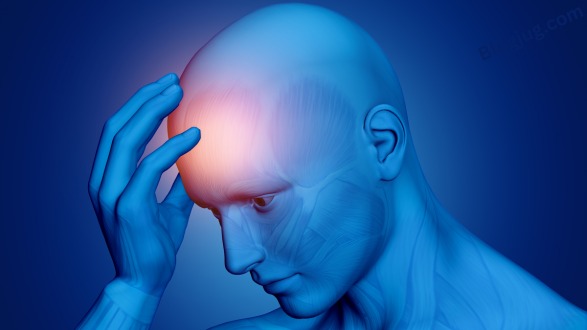A migraine is not just a bad headache. You can spend days in bed due to incapacitating, throbbing, one-sided headache agony from it. Exhaustion, nausea, changes in vision, irritation, and other symptoms can be brought on by movement, lights, sounds, and other stimuli. So that migraines don’t take over your life, a healthcare professional can assist you in managing your symptoms.

Overview
What is a migraine?
A migraine is a strong headache that radiates to one side of the brain and generates pulsating, throbbing pain. A migraine headache phase typically lasts four hours or longer, but it sometimes lasts for days. This headache intensifies when:
1. powerful smells.
2. Loud sounds.
3. Bright lights.
4. Physical activity.
The migraine is inconvenient. They may disrupt your daily schedule and make it more difficult for you to fulfill your social and personal commitments. You can get treatment to help you control your migraines.
What are the types of migraines?
Migraines can be of several sorts. The most typical types of migraines are:
1. Aura-accompanied migraine (classic migraine).
2. Aura-free migraine (common migraine).
The stage of a migraine before the head pain starts is called an aura.
Other varieties of migraines consist of:
1. Migraines in children
2. Recurring migraine.
3. Hemiplegic migraine.
4. Migraines while menstruation.
5. Migraine without head pain
6. Status migrainosus.
How common are migraines?
People frequently have migraines and headaches. According to studies, 12% of Americans are thought to suffer from migraine headaches.
Symptoms and Causes
What are the phases of a migraine?
A migraine occurs in four stages or phases:
1. Prodrome: Up to 24 hours before you get a headache, the first stage starts.
2. Aura: A cluster of sensory, motor, and/or verbal symptoms known as an aura serves as a warning to a migraine headache. The aura phase may extend to 60 minutes or to just five. It’s possible for you to feel the aura and headache simultaneously.
3. Headache: A migraine headache can linger anywhere from four to 72 hours.
4. Postdrome: Typically, the postdrome phase lasts anything from a few hours to 48 hours. The postdrome phase is referred to as a migraine hangover because symptoms resemble an alcohol-induced hangover.
The four stages might take anywhere from eight to 72 hours to complete.
Migraine symptoms
Depending on the stage, migraine headache symptoms change. Since each migraine is different, you might not always have symptoms during all four phases of the attack.
Prodrome symptoms
1. Fatigue.
2. Nausea.
3. Frequent urination.
4. Mood changes.
5. Trouble sleeping.
6. Increased hunger and thirst.
7. Difficulty concentrating.
Aura symptoms
1. Weakening of the muscles.
2. Vision changes.
3. A ringing sound in your ears.
4. Difficulty focusing or speaking.
5. Tingling and numbness.
6. Touch sensitivity.
Headache attack symptoms
Headache increases in severity over time. It may impact one or both of your head’s sides. Along with other symptoms, it may manifest as:
1. Vomiting as well as nausea.
2. Smell, light, and sound sensitivity.
Postdrome symptoms
1. Nausea.
2. Dizziness.
3. Fatigue.
4. Stiff neck.
5. Sound and light sensitivity.
6. Inability to concentrate.
What does a migraine feel like?
Pain from a migraine headache may feel like this:
1. Pulsing.
2. Pounding.
3. Throbbing.
4. Dull.
Everybody experiences a migraine headache differently. There are various severity levels for migraine headaches. One side of the head may pain first, then the other. In addition, pain in the vicinity of your eyes or temples may occasionally radiate to your face, sinuses, jaw, or neck.
How often do migraines happen?
Each person experiences migraines at different frequencies. One migraine may occur once a year or once a week. Most people encounter two to four times a month on average. They occur most frequently in the morning. The majority of migraines are random, but occasionally, such as right before a period or right after experiencing stress, you may predict when one will occur.
What causes a migraine headaches?
Although the precise etiology of migraine headaches is unknown, research indicates that heredity may be a factor.
When you experience a headache, specific blood vessel nerves send pain signals to your brain. This causes the blood vessels and nerves in your head to become inflamed. Your nerves do that for no apparent reason.
What triggers a migraine?
Something that sets off symptoms is called a trigger. some Among the most typical migraine triggers are:
1. Stress.
2. Hormonal changes.
3. Certain drugs.
4. Alterations to your sleep patterns.
5. The weather fluctuates.
6. Too much in physical activities
7. Addictive drugs, such as smoke or coffee.
8. Skipping a meal.
9. Exposure to strong smells, loud noises, or bright lights.
You can find your triggers with the assistance of your healthcare provider. To monitor commonalities between migraine attacks, they can advise maintaining a migraine notebook.
What foods trigger migraines?
Certain chemicals and preservatives in food may cause sensitivities in your body. This sensitivity increases the likelihood of a migraine, particularly when paired with additional triggers.
Among the most typical dietary triggers are:
1. Cheese that has aged.
2. Chocolate.
3. Food additives such as MSG and nitrates.
4. Prepared or preserved foods
5. Pickled or fermented foods.
6. Drinks that have alcohol in them.
Are migraines hereditary?
Indeed, migraineurs typically come from biological families. 80% of migraineurs have a first-degree biological relative who also suffers from the headache disorder.
What are the risk factors for a migraine?
From toddlers to adults, anyone might get a migraine. The likelihood of experiencing a migraine is higher in women and those labeled as female at birth than in men and those identified as male at birth.
There are additional risk factors that could increase your likelihood of having a migraine, such as:
1. Migraines in the biological family history.
2. Usage of tobacco products regularly.
3. Underlying health issues (depression, anxiety, sleep disorders, and epilepsy).
Diagnosis and Tests
How is a migraine diagnosed?
After doing a neurological and physical examination, a medical professional will identify a migraine headache. Your medical history and the health history of your biological family will also be further investigated. To find out more about your symptoms, your doctor might ask you the following questions:
1. Which symptoms are you experiencing?
2. What is the location and sensation of your headache?
3. What level of severity do you have?
4. What was the duration of your symptoms?
5. Has anything improved or made your headache worse?
Blood tests and imaging tests (such as an MRI or CT scan) may also be prescribed by your doctor to rule out any other possible reasons for your headache. Your doctor may use an electroencephalogram (EEG) to rule out further conditions.
Who diagnoses a migraine?
Speak with your primary care physician (PCP) about your symptoms if you believe you are suffering from a migraine. They can identify migraines and begin treating them. Your PCP might recommend that you see a neurologist or headache specialist.
Management and Treatment
How is a migraine treated?
Migraine is an incurable condition. Yet, a medical professional can assist you in controlling your migraine symptoms by doing the following:
1. Taking prescription drugs.
2. Avoiding things that can cause migraines and headaches.
3. Utilizing non-traditional migraine treatments.
What medications treat migraines?
If you have migraines, your doctor may advise you to take medication. There are two types of medications available:
1. Medications to stop migraines: These drugs can be taken as soon as a migraine appears. They eliminate or lessen sensitivity, discomfort, nausea, and other migraine symptoms.
2. Medications to prevent migraines: Preventive medication is typically prescribed by a healthcare physician if you suffer from severe symptoms that disrupt your daily routine or if you have migraines frequently. These drugs lessen the frequency and intensity of your migraine attacks. You can take these drugs as prescribed, usually once a day.
Typical drugs used to treat migraines include:
1. Triptans.
2. Ditans.
3. Gepants.
4. Dihydroergotamine.
5. Antiemetic medications.
There are numerous formats in which medications can be found, including:
1. An injection under the skin.
2. An oral drug.
3. A spray for the nose.
4. Using an IV
5. Suppository.
Your doctor and you will talk about the exact drug, drug combination, and formulation that will help you manage your symptoms the best. Use of all drugs must be supervised by a headache specialist or provider. It’s crucial to carefully follow your provider’s recommendations when taking any medication.
Over-the-counter migraine medications
If your migraine symptoms are mild to severe, over-the-counter drugs can help. The primary components of drugs that relieve pain are aspirin, ibuprofen, acetaminophen, naproxen, and caffeine.
When using over-the-counter pain medicines, exercise caution. Overuse can occasionally result in dependency issues or headaches associated with an analgesic rebound. Inform your healthcare practitioner if you take over-the-counter painkillers more frequently than twice or three times a week. They might recommend prescription drugs that work better.
Avoiding migraine triggers
You can determine what causes your migraines with the assistance of a medical professional. They might ask you to maintain a migraine diary or journal. You can record when, how you felt, and how long a migraine lasted by keeping a migraine journal. To find out more about any potential triggers, you can also provide information on the meals you consumed or the activities you took part in.
You can keep a migraine notebook with the help of certain smartphone apps.
You can take action to prevent a trigger once you’ve identified it. Although it’s not always feasible, being aware of your triggers might help you find them and take appropriate action when a migraine threatens you.
To help you manage your stress, you might wish to consult a mental health expert if stress is a trigger for you. Set a phone alarm to remind you to eat meals on a regular schedule if missing meals causes migraine symptoms.
Alternative migraine remedies
To assist you manage your migraines, you might wish to consider alternative therapy. Among them are:
1. Consuming certain vitamins, minerals, or herbs, such as co-enzyme Q10, feverfew, butterbur, magnesium, or riboflavin (vitamin B2).
2. Methods of relaxation such as yoga.
3. Biofeedback.
4. Acupuncture.
5. Injections of type A botulinum toxin
Consult your physician before beginning any alternative migraine treatments.
What migraine treatments are available during pregnancy?
If you have migraines and are pregnant or intend to become pregnant, see your doctor. When taking migraine medication during pregnancy or if you suspect you could become pregnant, your doctor may advise against it. Certain drugs may have detrimental effects on the development of the fetus.
Alternative treatments, such as acetaminophen pain relievers for migraines, can be suggested by your practitioner.
How should I handle a migraine as soon as it occurs?
When a migraine episode occurs, you can do the following to help yourself feel better:
1. Sleeping in a nice, quiet, and dark environment.
2. Put a washcloth or cold or warm compress behind your neck or on your forehead.
3. Massaging your head.
4. Circularly applying pressure to your temples.
5. Remaining composed and patient
Prevention
Can a migraine be prevented?
Not every migraine can be avoided. However, you can lessen the frequency and intensity of migraine attacks by taking preventive medicine as prescribed by your doctor. Additionally, you can collaborate with your healthcare professional to identify and prevent your triggers by learning more about them.
Outlook / Prognosis
What’s the outlook for a migraine?
Everyone’s experience with migraines is unique. They’re temporary, they will return throughout your life. Additionally, there isn’t a cure. You can control your migraines to make them less severe and go away more quickly by seeing your healthcare professional. Finding the ideal course of treatment for you could take some time. Inform your physician if your symptoms get better or worse.
Living With
When should I see a healthcare provider?
Make an appointment with your physician if you encounter:
1. New symptoms.
2. Worsening symptoms.
3. Treatment-related side effects.
Make an immediate call to 911 (or your local emergency services number) or visit an emergency room if you:
1. Have the most painful headache of your life.
2. Have recently developed neurological symptoms that you have never had before, such as trouble speaking, dizziness, balance issues, visual problems, confusion, seizures, or tingling or numbness.
3. After suffering a head injury, get headaches.
What questions should I ask my healthcare provider?
1. Will my migraines go away?
2. Which drugs would you suggest?
3. How do I avoid getting migraines?
4. What kind of migraine am I experiencing?
5. Do my migraines qualify as chronic pain?
A note from Blogjug
A migraine is not like a headache, which you have probably experienced before. Sometimes it seems as though everything is ending and there is nothing you can do to stop it. Time seems to be against you and moving more slowly during the period of a migraine, even though your symptoms are just momentary. However, there are ways to treat migraines so they don’t ruin your day by managing them as they happen. You can avoid having migraines take over your life by seeking assistance from a healthcare expert.









4 thoughts on “Migraine Headaches: Understanding, Managing, and Finding Relief”